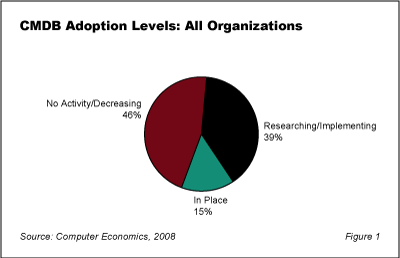All IT managers need up-to-date knowledge of their organizations’ IT assets and resources. Due to the dynamics of technology and changes in the business, IT configurations are constantly changing. Knowing the current state of each asset and its relationships to others is essential for making wise purchasing, operational, maintenance, and upgrade decisions. Furthermore, accurate records are often necessary to meet licensing requirements and comply with regulations such as Sarbanes-Oxley. Yet maintaining timely information on all of an organization’s IT assets, their configurations, and how those assets relate to each other can be a monumental task.
This Research Byte is a summary of our full report, Configuration Management Database ROI Requires Careful Implementation.
One much-discussed solution to this problem is the Configuration Management Database (CMDB) system. Configuration management (CM) is a methodology for collecting, revising, storing, and retrieving information about a company’s IT assets, their configurations, and the relationship between those assets. One framework for defining best practices in configuration management is the Information Technology Infrastructure Library (ITIL). ITIL recommends that this information be managed by means of a Configuration Management Database (CMDB). A CMDB stores data related to IT entities, which may be physical or conceptual and may include hardware, software, documentation, or even personnel.
Once established, the CMDB becomes the source of authorized configurations for all IT infrastructure components. Configuration items (CIs) comprise the database’s components, which are described by relational, technical, and ownership attributes. Because there are a large quantity of CIs that must be tracked and because the CI data continually changes, the CMDB processes require a high degree of automation to be practical.
CMDB Is in the Early Adopter Stage
A Computer Economics survey of more than 200 CIOs and senior IT managers found that adoption of CMDB solutions is still at an early stage. Figure 1 shows that only 15% of companies have a CMDB solution in place, according to our survey from the first half of 2007. Another 39% of the companies are either researching or in the process of implementing a CMDB. The largest group (46%) reports no activity underway on CMDB adoption, indicating that their interest level remains relatively limited.

The full version of this report provides adoption trends of CMDB solutions among small, medium, and large companies and the return on investment (ROI) and total cost of ownership (TCO) experiences of the companies that have implemented these systems. We also provide a description of common CMBD structures and recommendations on how best to utilize them. We conclude with recommendations for companies considering implementing a CMDB solution.
This Research Byte is a brief overview of our report on this subject, Configuration Management Database ROI Requires Careful Implementation. The full report is available at no charge for Computer Economics clients, or it may be purchased by non-clients directly from our website at https://avasant.com/report/configuration-management-database-roi-requires-careful-implementation-2008/ (click for pricing).
For further research on CMDB implementation, please see Federated Approach to Configuration Management Database Yields Quickest Benefits (click for pricing).

